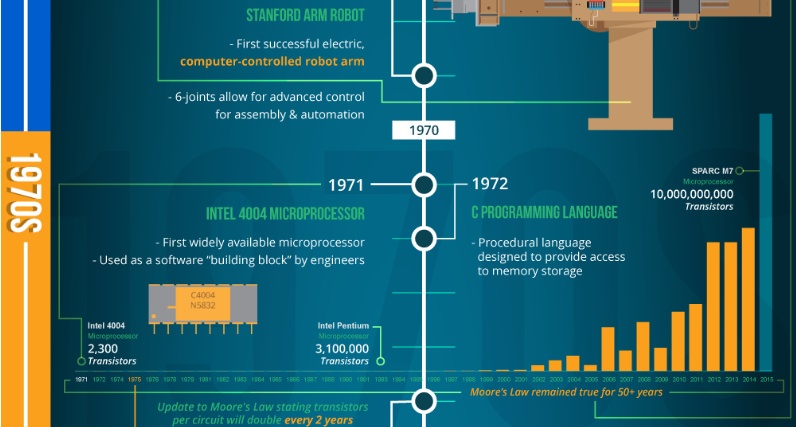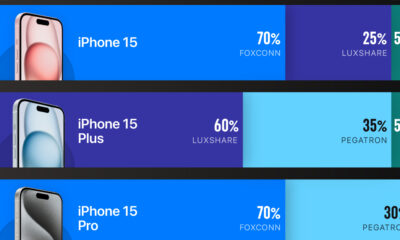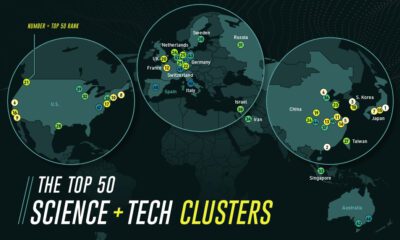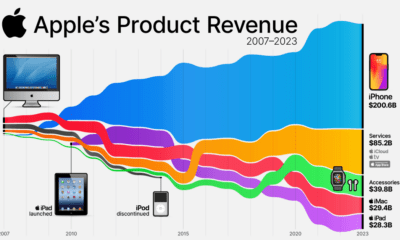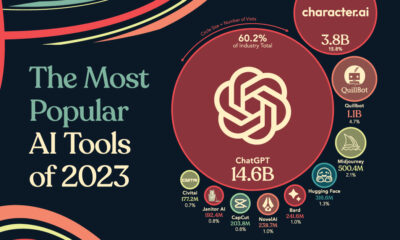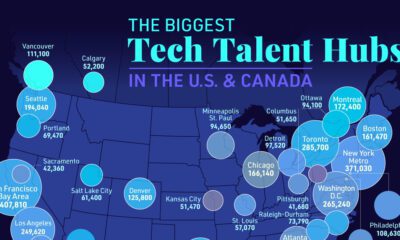Technology
The Evolution of Computer Science in One Infographic
We take computing power for granted today.
That’s because computers are literally everywhere around us. And thanks to advances in technology and manufacturing, the cost of producing semiconductors is so low that we’ve even started turning things like toys and streetlights into computers.
But how and where did this familiar new era start?
The History of Computer Science
Today’s infographic comes to us from Computer Science Zone, and it describes the journey of how we got to today’s tech-oriented consumer society.
It may surprise you to learn that the humble and abstract groundwork of what we now call computer science goes all the way back to the beginning of the 18th century.

Incredibly, the history of computing goes all the way back to a famous mathematician named Gottfried Wilhem Leibniz.
Leibniz, a polymath living in the Holy Roman Empire in an area that is now modern-day Germany, was quite the talent. He independently developed the field of differential and integral calculus, developed his own mechanical calculators, and was a primary advocate of Rationalism.
It is arguable, however, that the modern impact of his work mostly stems from his formalization of the binary numerical system in 1703. He even envisioned a machine of the future that could use such a system of logic.
From Vacuums to Moore’s Law
The first computers, such as the IBM 650, used vacuum tube circuit modules for logic circuitry. Used up until the early 1960s, they required vast amounts of electricity, failed often, and required constant inspection for defective tubes. They were also the size of entire rooms.
Luckily, transistors were invented and then later integrated into circuits – and 1958 saw the production of the very first functioning integrated circuit by Jack Kilby of Texas Instruments. Shortly after, Gordon Moore of Intel predicted that the number of transistors per integrated circuit would double every year, a prediction now known as “Moore’s Law”.
Moore’s Law, which suggests exponential growth, continued for 50 years until it started scratching its upper limits.
It can’t continue forever. The nature of exponentials is that you push them out and eventually disaster happens.
– Gordon Moore in 2005
It’s now been argued by everyone from The Economist to the CEO of Nvidia that Moore’s Law is over for practical intents and purposes – but that doesn’t mean it’s the end of the road for computer science. In fact, it’s just the opposite.
The Next Computing Era
Computers no longer take up rooms – even very powerful ones now fit in the palm of your hand.
They are cheap enough to put in refrigerators, irrigation systems, thermostats, smoke detectors, cars, streetlights, and clothing. They can even be embedded in your skin.
The coming computing era will be dominated by artificial intelligence, the IoT, robotics, and unprecedented connectivity. And even if things are advancing at a sub-exponential rate, it will still be an incredible next step in the evolution of computer science.
Technology
Ranked: Semiconductor Companies by Industry Revenue Share
Nvidia is coming for Intel’s crown. Samsung is losing ground. AI is transforming the space. We break down revenue for semiconductor companies.
Semiconductor Companies by Industry Revenue Share
This was originally posted on our Voronoi app. Download the app for free on Apple or Android and discover incredible data-driven charts from a variety of trusted sources.
Did you know that some computer chips are now retailing for the price of a new BMW?
As computers invade nearly every sphere of life, so too have the chips that power them, raising the revenues of the businesses dedicated to designing them.
But how did various chipmakers measure against each other last year?
We rank the biggest semiconductor companies by their percentage share of the industry’s revenues in 2023, using data from Omdia research.
Which Chip Company Made the Most Money in 2023?
Market leader and industry-defining veteran Intel still holds the crown for the most revenue in the sector, crossing $50 billion in 2023, or 10% of the broader industry’s topline.
All is not well at Intel, however, with the company’s stock price down over 20% year-to-date after it revealed billion-dollar losses in its foundry business.
| Rank | Company | 2023 Revenue | % of Industry Revenue |
|---|---|---|---|
| 1 | Intel | $51B | 9.4% |
| 2 | NVIDIA | $49B | 9.0% |
| 3 | Samsung Electronics | $44B | 8.1% |
| 4 | Qualcomm | $31B | 5.7% |
| 5 | Broadcom | $28B | 5.2% |
| 6 | SK Hynix | $24B | 4.4% |
| 7 | AMD | $22B | 4.1% |
| 8 | Apple | $19B | 3.4% |
| 9 | Infineon Tech | $17B | 3.2% |
| 10 | STMicroelectronics | $17B | 3.2% |
| 11 | Texas Instruments | $17B | 3.1% |
| 12 | Micron Technology | $16B | 2.9% |
| 13 | MediaTek | $14B | 2.6% |
| 14 | NXP | $13B | 2.4% |
| 15 | Analog Devices | $12B | 2.2% |
| 16 | Renesas Electronics Corporation | $11B | 1.9% |
| 17 | Sony Semiconductor Solutions Corporation | $10B | 1.9% |
| 18 | Microchip Technology | $8B | 1.5% |
| 19 | Onsemi | $8B | 1.4% |
| 20 | KIOXIA Corporation | $7B | 1.3% |
| N/A | Others | $126B | 23.2% |
| N/A | Total | $545B | 100% |
Note: Figures are rounded. Totals and percentages may not sum to 100.
Meanwhile, Nvidia is very close to overtaking Intel, after declaring $49 billion of topline revenue for 2023. This is more than double its 2022 revenue ($21 billion), increasing its share of industry revenues to 9%.
Nvidia’s meteoric rise has gotten a huge thumbs-up from investors. It became a trillion dollar stock last year, and broke the single-day gain record for market capitalization this year.
Other chipmakers haven’t been as successful. Out of the top 20 semiconductor companies by revenue, 12 did not match their 2022 revenues, including big names like Intel, Samsung, and AMD.
The Many Different Types of Chipmakers
All of these companies may belong to the same industry, but they don’t focus on the same niche.
According to Investopedia, there are four major types of chips, depending on their functionality: microprocessors, memory chips, standard chips, and complex systems on a chip.
Nvidia’s core business was once GPUs for computers (graphics processing units), but in recent years this has drastically shifted towards microprocessors for analytics and AI.
These specialized chips seem to be where the majority of growth is occurring within the sector. For example, companies that are largely in the memory segment—Samsung, SK Hynix, and Micron Technology—saw peak revenues in the mid-2010s.
-

 Green2 weeks ago
Green2 weeks agoRanked: Top Countries by Total Forest Loss Since 2001
-

 Travel1 week ago
Travel1 week agoRanked: The World’s Top Flight Routes, by Revenue
-

 Technology1 week ago
Technology1 week agoRanked: Semiconductor Companies by Industry Revenue Share
-

 Money2 weeks ago
Money2 weeks agoWhich States Have the Highest Minimum Wage in America?
-

 Real Estate2 weeks ago
Real Estate2 weeks agoRanked: The Most Valuable Housing Markets in America
-

 Markets2 weeks ago
Markets2 weeks agoCharted: Big Four Market Share by S&P 500 Audits
-

 AI2 weeks ago
AI2 weeks agoThe Stock Performance of U.S. Chipmakers So Far in 2024
-

 Automotive2 weeks ago
Automotive2 weeks agoAlmost Every EV Stock is Down After Q1 2024

